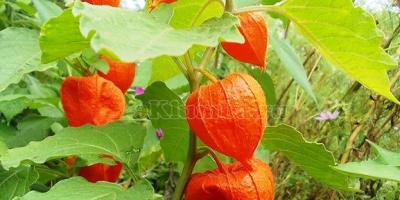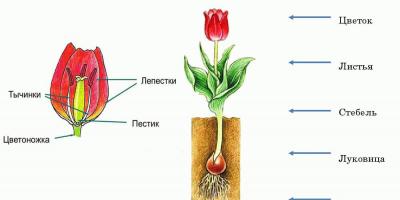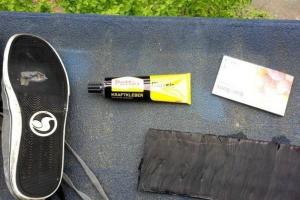Physalis is an amazing plant that protects the human body. But its healing and beneficial properties are not yet fully understood, and much remains to be discovered. But some time ago everyone thought that it was a weed growing along the edge of the garden and serving only to decorate autumn bouquets.
The plant chooses for its growth the light forests of Bulgaria and Russia, it is found in the Baltic states and the Caucasus. The plant originates from South and Central America.
Useful properties of physalis
Physalis is a perennial plant belonging to the nightshade family, grows to a height of 50 to 100 cm, the roots are creeping and strongly branching. The shoots are erect and the foliage grows opposite with slightly serrated edges.
The flower buds are located in the axils of the leaves and, when opened, grow into white or beige flowers. The cup of the peduncle looks like a bell, inside of which there is a juicy orange fruit. The flowering of this plant continues all summer, and the fruits ripen by August and September, which is due to the type of physalis. read here.
Physalis has always been a medicinal plant. With its help, they fight with various human ailments:
- diuretic;
- hemostatic;
- choleretic;
- antiseptic;
- painkillers.

From this plant, you can prepare dietary products. From it you can cook first and second courses, canned vegetables. Jam is made from it and useful vitamin juices are prepared.
For medicinal purposes, all parts of the physalis are used. Roots accumulate a lot of alkaloids, leaves - carotenoids, berries - carbohydrates.
With the help of this plant, various diseases are treated, for example, rheumatism, gout, various diseases of the genitourinary system and many other different diseases.
- Extracts and tinctures are drunk with urolithiasis, bronchitis and edema, rheumatism and bruises;
- Fresh fruits and juice are used for dermatoses, gonorrhea and dysentery, for hypertensive crises;
- With a strong cough and bronchitis, a decoction is prepared from the rhizome of the plant, it also helps to stop menstruation;
- In Central Asia, the berries of the plant are used to treat anemia, and it also helps old people who suffer from constipation. Tea is brewed from it, using leaves and covers of fruits;
- In Tajikistan, juice and gruel from physalis leaves are boiled over low heat. This decoction is combined with milk, and sore throats and stomatitis in children are treated.
Now medicine uses it as a dietary supplement and a multivitamin solvent for people who suffer from gastritis, diabetes, and cholecystitis. Such people are recommended to take fresh fruits in the amount of 10 pieces before meals for a quarter of an hour.
Today, a gel is produced from the fruits of physalis, which is used in inflammatory processes of the skin. It enhances skin regeneration and promotes wound healing.

Hazardous Properties
Physalis is a very valuable low-calorie dietary product. But we must remember that all parts of the plant are poisonous and therefore they should not be taken without consulting a doctor. You also need to be sure that you are going to cook food from a vegetable variety, and not from an ornamental one. Since decorative physalis is not eaten!
People who have an increased acidity of the stomach should carefully take medicines made on the basis of physalis. It is recommended to start with a couple of berries to understand how the stomach reacts to the fetus.
How to cultivate this plant? There is nothing difficult because it is from the nightshade family and its cultivation is similar to the cultivation of a tomato.
There are different types of this plant:
- vegetable;
- strawberry;
- decorative.

Features of growing vegetable physalis
The plant has small seeds, they are checked for germination by pouring them into a bowl of salt water. All those seeds that float can be thrown away, and those that lay on the bottom, we will plant in previously prepared soil. To disinfect the earth, just before sowing the seeds, it must be shed with a weak solution of potassium permanganate.
The soil for planting seeds must be loose and fertile. Therefore, we dig up the ridge allotted for planting and sprinkle it with ash and rotted humus. The place should be sunny, as physalis does not grow in the shade.
The predecessors of Physalis can be any vegetable crops, except for nightshade crops. Since planting a plant will take away those infections that have been accumulated, for example, on tomatoes or eggplants. Although, if the size of the earth is limited, then you can see that any sore can hardly cling to the physalis.
Vegetable physalis is usually bred by self-sowing, as it is not afraid of cold weather. Therefore, it is good to sow it in the ground in the fall. At the same time, young shoots are strong and more hardened than seedlings grown at home, which were sown at the end of winter.
Physalis, planted immediately in the ground, begins to bear fruit 14 days later than grown with seedlings. Therefore, if a harvest is needed at the beginning of summer, then they are planted with the help of seedlings, and then the fruiting of physalis, planted before winter, comes into force.

Young plants grow very quickly, it takes them a month to reach the age suitable for planting seedlings in ridges. Consequently, the sowing of seeds begins in mid-April, so that after 25-30 days it can be transplanted to the ridge of its site. It is planted a couple of weeks earlier than tomatoes, as the seedlings of the plant are not afraid of light spring frosts.
The seedlings themselves are planted in any way possible, as well as. First, the seeds are sown in a small bowl, when two true leaves grow, they dive into separate small cups. Or, without saving space, they sow 2 seeds in a container so as not to disturb the root system of the plant with a pick.
Seedlings are watered well, but without fanaticism, otherwise the sprouts may get sick with a black leg. You can sow the seeds immediately on the ridge and, after abundant watering, cover the entire ridge with a heater, for example, a film for greenhouses.
Seedlings for all the time of growth should be fed a couple of times with infusion of mullein diluted one to ten. It is necessary to water the infusion carefully so as not to burn the leaves.
By mid-May, seedlings that have been properly cared for will have five to six true leaves and will be completely ready for planting on the ridges. But so that she does not die, on the very first day, she must be accustomed to the open air, taking it out to breathe it first for a couple of hours a day, putting it in the shade, and then for the whole day.
Physalis grows rapidly in size, so it is planted in a checkerboard pattern in increments of 50 cm. It is watered abundantly only when planting seedlings, then watered if there are dry days in the region.
Actually, all care for physalis comes down to weeding and rare watering. During the ripening of the fruits, watering should be stopped so that they are not watery. The plant does not require pinching, since the more branches, the more fruits growing in the axils of the leaves.
Ripening occurs from the lower tier of fruits. When ripe, if not cut off, they can fall to the ground. This does not spoil the appearance of the berries, you can collect them and cook those dishes that you like. The ripeness of the berry depends on the variety, therefore, when planting a certain variety, you need to familiarize yourself with the annotation of how the fruit will look like in a mature state.

If the first cold snaps in the region occur already in September, then physalis bushes can be dug up along with unripe fruits and hung in a barn until the fruits ripen.
Features of growing strawberry physalis
It is also called berry physalis or Florida. The berries are about the size of a pea, but very sweet in taste. This type is recommended for those who are diabetic. Up to 3 kg are collected from one bush. fragrant berries.
The difference between planting strawberry and vegetable is that it is afraid of a cold snap and is planted on June 5-10, when the return frosts have passed. And so, the cultivation of seedlings and care completely coincides with the previously described method.
Features of growing ornamental physalis
 decorative physalis
decorative physalis Physalis edible and inedible - how to distinguish?
Decorative physalis has beautiful large lanterns and small berries inside. These berries have a bitter taste and are not suitable for cooking. These Chinese lanterns are very suitable for the design of a garden or an apartment.
 edible physalis
edible physalis Edible physalis looks much more modest than decorative. But they have a large fruit resembling a small tomato.
From the fruit you can cook many different wonderful dishes. This American fruit easily fits into our everyday cuisine. Therefore, using your imagination, you can cook various culinary masterpieces.
But the technology for preparing physalis fruits has its own little trick. It is necessary to wash off the sticky coating from the fetus. To get rid of the plaque, it is necessary to pour the fruits with boiling water for five minutes. After such processing, the bitterness of the fruit will go away.
Pickled Physalis
Ingredients:
- 1 kg - vegetable physalis.
- 50 gr. - spices.
- 50gr. - sugar.
- 2 tablespoons - vinegar 9%.
- 3 large cloves of garlic.
- 1l. water.
We wash off the sticky coating from the berries and put them in layers in a prepared container, sprinkling with spices. For spices, various leaves are taken: currants, parsley, dill. We prepare the brine - for this, pour sugar and vinegar into the water according to the recipe.
Bring to a boil and pour the brine into a jar of fruits for about half an hour. Then pour this brine into a saucepan and boil it a second time. While it boils, finely chopped garlic is placed in jars. When the brine boils, it is poured into a jar and rolled up.

physalis jam
Ingredients:
- 1 kg. physalis.
- 1 kg. Sahara.
Cut the fruit and add a glass of water. Bring to a boil, and as it heats up, add sugar. Next, the resulting mass is boiled in a steam bath. And so cook until the jam thickens. Further, if desired, you can eat immediately, or you can roll it into sterilized jars.
6 minutes to read
When you first saw the physalis in the photo, it’s hard to guess that a ripe fruit is hiding inside its bright, airy orange calyx. Its unusual structure served as fertile ground for the emergence of many poetic names for this plant - Chinese lantern, strawberry tomato, Peruvian gooseberry. Both decorative and edible varieties have a bright appearance. Therefore, do not be too lazy to sow physalis - growing and caring will not only decorate the summer cottage, but will also allow you to surprise your family with an unusual culinary dish.
Plant features
Physalis is a herbaceous plant, the cultivation of which is possible both as an annual and as a perennial crop. These bright representatives of the nightshade family are used in ornamental gardening. Plants are quite tall, the length of the stem reaches about 60 cm. Light green leaves are oval in shape with a pointed end. The flowers have an inconspicuous appearance, decorative effect is provided by bright air boxes, similar to thin paper bubbles, in which tight physalis fruits ripen.

decorative physalis
With the onset of cold weather after the leaves fall in autumn, physalis does not lose its attractive decorative appearance. The fruits, covered with a thin film of red, orange color of the pericarp, continue to stick to the stem. They are used not only in open ground, but also for decorating the interior as dry winter bouquets.
Reference. In addition to ornamental species, planting edible varieties of physalis in summer cottages has become widespread. Their fruits are pickled, salted, canned, used in salads, jam is made from them.
Varieties and types of physalis
Physalis is the most numerous genus of the Solanaceae family and is a close relative of the tomato, although at first glance you can’t tell from the photo. The largest species diversity of this plant is present in countries in Central and South America.

peruvian physalis
Both garden and pot crops are known. In our area, in open ground, three varieties of physalis are often cultivated:
- Ornamental physalis - among other things, known as physalis Franchet. It is its orange-red pericarp that most resembles Chinese lanterns, which contain small fruits. Its planting is carried out as a decorative element of the flower bed. It is undemanding in growing and care conditions, endures frosts.
- Vegetable physalis - is distinguished by large fruits - about 50 g, growth rate and the ability to rich harvests. Growing a crop is not distinguished by complex agrotechnical practices in the open field. Different varieties have their own flavors. In particular, "Korolek", "Moscow early" have a sweeter taste, in contrast to the bitterness of their kind.
- Berry physalis - also called strawberry. Its fruits fully justify such a name, since their weight rarely reaches 10 g, on average they are no more than 5 g. Strawberry is less frost-resistant, the fruit ripening period is longer and the yields are small. However, true gourmets are ready to endure such shortcomings for its excellent taste.
Preparing for landing
For those who are familiar with tomato farming, it will not be difficult to grow a plant such as physalis - planting and care are very similar. But compared to tomatoes, physalis in the open field is less demanding on the illumination of the area chosen for its reproduction.

Physalis raisin fruits
Success largely depends on the correct composition of the soil. For sowing take:
- 2 parts of peat;
- 1 part compost;
- 1 part of garden land;
- 0.5 parts of pure sand.
Important. Physalis does not respond well to high acidity of the soil. To reduce its level, for every 5 kg of soil mass, 2 tablespoons of ash are added.
Physalis planting
Reproduction of physalis is carried out through seedlings. It is planted in open ground upon reaching the age of 45-50 days, when the threat of frost has passed. Therefore, the term for planting seeds in the spring from this calculation is performed in mid-April.

Physalis seedlings
Planting includes the process of disinfecting seeds and nutrient substrate. The soil is treated with steam or heated in an oven. Seeds in a gauze bag are dipped for half an hour in a weak, barely pink solution of potassium permanganate. After such preparatory measures, you can start sowing. For this:
- Containers are filled with sifted soil and the substrate is lightly tamped.
- Seeds are pressed into the surface at an equal distance from each other.
- From above, earth is poured with a thickness of not more than 1 cm.
- The surface is compacted, after which the first watering is carried out.
- Crops are covered with transparent polyethylene or glass and left in a well-lit place.
- The temperature in the room is maintained at +15…+20°C.
- If the care was correct, seedlings will appear after a week. From this moment on, the shelter is removed. Care measures include regular watering.
The next stage of reproduction is the picking of seedlings. It is started when the first 2 true leaves appear. As part of the soil mixture, the amount of sand is reduced by 2 times. In addition, fertilizer is added to the soil for picking - 1 tablespoon of mineral supplements for every 5 kg of nutrient substrate.
Landing is carried out in separate cups. A hole is made in the ground deep enough to fit the roots of the seedlings. After planting, moderate watering is required. If after that the earth has settled, add more soil mixtures.
Seedling care is simple:
- The cups are kept in a place well lit by sunlight.
- The air temperature is maintained at +15…+20°С.
- The soil is kept moist, the earth must not be allowed to dry out.
- Fertilizer for seedlings is applied once every two weeks.
Important. So that planting seedlings in open ground does not end with the death of immature plants, in the spring it is necessary to harden tender sprouts. To do this, in good weather, they are taken out for an hour and a half to fresh air.
In the area allotted for physalis, other nightshades should not have grown in the last few years. If eggplants were cultivated here before, your physalis will develop poorly.
In the process of digging, fertilizer is applied - no more than 50 g of nitroammophoska per 1 sq. m. Test the acidity of the soil. If it is elevated, a glass of wood ash will fix it.
Planting pits on the ridges are located no closer than 50 cm. The indent between the rows is about 70 cm. Seedlings from cups, together with an earthen clod, are placed in a hole. Planting depth - to the bottom leaflet. The soil around the stem is carefully tamped. After planting, the soil is watered and mulched with peat.
Further care
Care for young plantings consists in weeding, loosening the soil and regular watering. Experienced gardeners know that tomatoes need a garter. His closest relative Physalis does not need such a measure. As well as stepson culture. On the contrary, the more the bush branches, the more bright fruits will be tied on the plant and will please the eye in the fall.
The variety of forms of currently cultivated plants allows you to create the most unusual landscape design and, along the way, derive practical benefits from it. Berry, vegetable and ornamental physalis is an unpretentious culture from the nightshade family. Some varieties can be used for medicinal and healing purposes. Physalis edible is used in canning and in dried form. The process of growing from seeds requires attention, time and some knowledge of agricultural technology. How to get strong seedlings and a high yield - we will tell in this article. In the meantime, we offer to look at the varieties of physalis in the photo:



Types and varieties of physalis (with photo)
A huge selection among the presented bags of seeds sometimes makes even experienced gardeners confused. Physalis species are usually divided according to the purpose of its cultivation:
- decorative varieties of physalis have pronounced aesthetic properties;
- vegetable varieties give a rich harvest of fruits weighing up to 150 grams;
- berry or strawberry physalis gives fruits of small mass (up to 10 gr.), which have excellent organoleptic qualities.
Varieties of ornamental physalis are most resistant to adverse environmental conditions. During the flowering period, they form a bright orange flashlight. Another name for the species is physalis Franchet or Chinese lantern. Can be used in winter flower arrangements as a dried flower.
The most popular varieties of vegetable physalis are Korolek and Early Moscow. You can see them in the photo below:




A distinctive feature is the high ripening rate and a wonderful sweetish taste. It is used in canning, in the preparation of jams and jams.
The widest palette of varieties is observed among the berry or strawberry varieties of Physalis - they are divided into three subspecies:
- the Peruvian type has fruits with a pronounced citrus aroma and taste, suitable for drying and jam;
- Florida physalis is used exclusively for jam, reminiscent of the taste and aroma of cherries;
- the sweetest and most delicious fruits can be obtained by planting raisin berry physalis - the tangerine flavor is preserved both during drying and when making jam.
When choosing a suitable physalis variety for growing from seeds in a personal plot, attention should be paid to the ripening time. The shorter the summer, the more early-ripening variety should be chosen. The way out of the situation can be a seedling method of growing. We will talk about it further. 


Growing physalis from seeds: planting and care
You can get a rich harvest or a magnificent decorative planting only with strict observance of the rules of agricultural technology. It is advisable to grow physalis from seeds in any climatic zone of Russia by seedlings. Sowing seeds for seedlings is carried out at the same time as for peppers or other nightshade crops. As a rule, by the time the seedlings are transplanted into open ground conditions, the seedlings should have reached the age of 60 days. Thus, if planting is planned at the end of May, then seedlings should be sown in mid-February. The term of emergence of shoots averages 20 - 27 days. How the planting of physalis is carried out and the subsequent care of seedlings and adult plants - we will tell further. 

So, the preparation begins with the processing of the soil. Requires humus-rich soil with the addition of river sand. The resulting soil is disinfected, calcined in the oven, treated with a hot solution of potassium permanganate and fungicides. After a day, you can start planting physalis seeds .. To do this, a container with low sides is filled with soil about half the height. Then the surface is slightly compacted. Seeds are laid out at an equal distance from each other. From above, it wakes up with a layer of earth for about 2/3 of the entire height of the walls of the container. After the emergence of seedlings, the remaining 1/3 of the height can be filled during the filling of the soil until the picking is carried out. After sowing, the surface is carefully watered with warm boiled water. The container is covered with polyethylene and placed in a warm dark place.
After germination, daily drip irrigation is carried out. Top dressing begins after picking (7 days after the procedure. Picking is necessary after the appearance of the first pair of true leaves. To do this, 1 seedling is taken out with a teaspoon and planted in separate peat pots with a diameter of up to 10 cm.
Top dressing in the process of growing seedlings can be carried out with complex fertilizers with mineral and organic components (Agricola, Giant, Fertika and others).
For active growth and development of physalis seedlings, an ambient temperature of at least 23 degrees Celsius is required. Daylight hours are also important. When shoots appear before March 20, daily additional lighting should be carried out using a phytolamp. It turns on for 3-4 hours every evening. 

Care for physalis when grown outdoors
Transplantation into open ground is carried out at the moment when the ambient temperature at night ceases to fall below +10 degrees Celsius. Before this moment, it is important to harden the seedlings, gradually increasing the time they spend outside from 30 minutes to 4 hours.
Caring for physalis when grown in open ground consists in regular watering and the application of mineral fertilizers in order to entrain the mass of the crop. A bed is being prepared before planting. It should not have grown potatoes, peppers or tomatoes in the previous 3 years. The best predecessors are carrots, beets, onions, cabbage, peas and beans. The site is carefully dug up and weeds are removed from it. Then humus should be added to the soil at the rate of 1 bucket per 1 sq. meter. Also, for each sq. meter is brought in 50 gr. nitroammofoski or any complex mineral fertilizer for nightshade crops. You can remove excess acidity with wood ash or slaked lime. 

For planting, prepare holes with a depth of up to 30 cm, the plants should be placed according to the scheme 70x70 cm. The stem of the seedling should be covered with earth until the first pair of true leaves. If the seedlings are very stretched, then you can increase the depth of planting in open ground. After planting, you need to water and mulch the soil with sawdust treated with nitrogen.
In the period until the seedlings get stronger in a new place, it is very important to shelter them from the scorching rays of the sun and possible pests. The soil should be kept loose and weed-free. For shelter, you can use a translucent film, for example, lutrisil or spunbond. Top dressing begins 2 weeks after transplantation. The first two are carried out with a diluted mullein or chicken with the addition of nitrogen. Then, before budding, mineral compositions intended for nightshade crops are used as dressings. Root top dressing should be applied no more than 1 time per week.
Most varieties of Physalis do not require additional support. These are strong bushes. In case of formation of too many stepchildren, they are pruned. Thus it is possible to form a decorative appearance and stimulate the formation of fruits of greater weight.
When signs of wilting or the presence of pests appear, all parts of the diseased plant should be removed. Regular spraying with fungicides and insecticides helps. 



Surely everyone has met this bright miracle called decorative physalis. It is simply impossible to pass by him without noticing. Physalis attracts attention with its conspicuous orange color and unusual shape. It is also popularly called the Chinese lantern. By the way, the name of the plant comes from the Greek (Physalis), which means “bubble” in translation. It is about what constitutes a decorative physalis, cultivation, methods of reproduction, care, planting, use in interior design and will be discussed in this article.
Physalis ornamental Alkekengi
Physalis ornamental is a herbaceous perennial culture belonging to the nightshade family (Solanoideae). The stem can be up to 90 cm long. The leaves are oval, pointed at the ends, of an unsaturated green color. Blooms in summer. Flowers are white inexpressive. A decorative look is given to the plant by orange swollen bubbles with a diameter of 6 cm with fruits ripening by autumn inside. Each branch is decorated with 10-15 lanterns. Fruits of ornamental varieties are not suitable for food, because they are poisonous.
For the purpose of decorative design, Physalis Alkekengi or common physalis (Physalis alkekengi) and physalis Franchet (Physalis francheti) are planted. It got its name in honor of the French botanist Adrien René Franchet, who first studied this variety of physalis, which came to us from Japan. It has been planted as an ornamental crop since 1894.
Video "Physalis decorative and edible"
Preparing for landing
Physalis is very unpretentious. Drafts and winds are not afraid of him. It withstands low temperatures well. Best of all, of course, the culture will bloom on the open sunny side of your garden.
When choosing soil for physalis, pay attention to its acidity. Acidic soil is not suitable for breeding. Also, swampy places, areas where groundwater is high, will not work. Suitable for cultivation will be calcareous or neutral soil.
It is also worth paying attention to the fact that physalis is not grown where nightshade crops used to grow. However, he will feel great in the territory where cabbage, cucumbers, root crops and legumes were grown.
The land for the plant must be prepared: add humus, compost, stale manure, peat and ash. Instead of organics, you can make a complex-mineral substrate.
Breeding and planting methods

Physalis decorative Franchet
There are several ways to reproduce physalis.
Growing seedlings
- Preparatory stage.
For 30 minutes, for disinfection, the seeds are kept in a weak solution of potassium permanganate, having previously covered them with gauze. Heat treatment of the soil is carried out using hot steam or an oven.
- Sowing.
Seeds are pressed into a container filled with soil, observing equal intervals between them. Sprinkle 1 cm of earth on top and water. Next, cover with a transparent film or glass and put in a well-lit place. In this case, the room temperature should be 15-20 C. When seedlings are formed, the film is removed and watered regularly. Sowing time is mid-April.
- Picking seedlings in individual containers.
Produced when the first two true leaves appear. The soil is enriched with mineral fertilizers. Planting is completed with moderate watering. Care requirements: a sunny place, maintaining a temperature of 15-20 C, regular watering, fertilizing the soil once every 14 days.
Planting seedlings in open ground in 45-50 days towards the end of May. While the plant adapts, it is necessary to provide constant watering and shelter from the midday sun. During planting, we observe a distance of 50 cm between sprouts and 70 cm between rows.
Sowing seeds in the ground
Division of the rhizome
The most effective method of culture propagation is division. The root system of physalis tolerates adaptation to a new place well. Separation is carried out in spring or autumn.
cuttings
Another method of propagation is cuttings. They are cut in July. Choose the tops of the shoots, having from 2 to 3 buds. Root cuttings under standard conditions. They are planted in loose soil, deepened to half the length, watered and covered with polyethylene with a hole for ventilation. In clear weather, the cuttings provide shade, preventing drying out. After rooting, the coating is removed, and the plant is provided with the necessary care.
Care
Care includes the following standard procedures:
- watering,
- weeding,
- loosening,
- top dressing.
Decorative physalis is quite resistant to drought. It should be watered only during prolonged dry weather.
All physalis, including ornamental varieties, do not like to coexist with weeds. At least once every 1-1.5 months it is necessary to weed and loosen the soil. Weeding can be omitted if you use the mulching technique.
Fertilize the crop optimally twice a year:
- in the early stages of development, when the plant begins to grow rapidly. Feed with humus, compost or wood ash, or complex mineral fertilizer;
- the second feeding is done as soon as the physalis blooms using similar means.
In order for the branches of the physalis to remain even for their subsequent use for decorative purposes, tying is necessary.
In the last days of August, in order for the “bubbles” to ripen before the onset of cold weather, pinch the tops of the plant.
Rejuvenation
Physalis must be rejuvenated quite often, as it grows rapidly and spreads to neighbors in the garden. Therefore, with a frequency of 5-7 years, the bushes rejuvenate, dividing and moving to a new place.
Video "Planting physalis decorative"
Disease and pest control
Diseases and pests in general will not be terrible for your pet, if you properly care for him, correctly selected the conditions for growing him.
Due to too wet soil, physalis is prone to the formation of rot on the stem. Aphids may appear if this perennial is adjacent to the affected plant or if proper watering was not provided for a long time on dry days. You can get rid of insects with the help of insecticides, and in case of diseases it is better to transplant the crop to a suitable place for it or provide proper care.
Also, physalis, like any other nightshade culture, can be affected by late blight. Signs of the disease are subcutaneous brown spots on leaves and fruits. This is facilitated by prolonged rainy weather and a tight fit. In order to prevent against late blight, it is necessary to spray the bushes with Bordeaux liquid before the formation of fruit ovaries.
At the stage of growing seedlings, physalis can suffer from black leg. The stem at the base becomes black and the sprout dies. Among the causes of the disease, excessive soil moisture can be distinguished, followed by acidification, cold and humid air. Seedlings affected by the disease must be removed, and the soil treated with fungicides. In order to prevent the disease, it is necessary to regularly loosen the soil, thinning seedlings in a timely manner.
Less common is the dangerous viral disease mosaic. The color of the leaves changes its color: some part of them brightens, while the other darkens. Plant diseases are caused by bacteria. Among the main reasons for the development of the mosaic is the wrong crop rotation of the plant. Sick specimens are uprooted and burned, a solution of potassium permanganate is added to the soil.
Application in the interior
Physalis is applicable not only in landscape design. It is often used to create decorative elements.
Bouquets of dried physalis flowers will look great. Keeping their appearance for a long time, they will create a summer mood on a winter evening. How to dry physalis?
Yes, very simple. In the fall, when the lanterns acquire their carrot color, the branches are cut along with the bubbles, the leaves are removed. If you plan to use physalis branches for prefabricated compositions, you need to dry them separately. If you want to create a bouquet, then you need to make it in advance, before drying. Dry physalis in the open air. The plant is suspended in a cool room with stems up. After two or three weeks, it is ready to create decorative compositions.




Don't limit your imagination. In addition to bouquets, using bright physalis boxes, you can create a variety of options for decorating your home. For example, make hanging garlands in the likeness of real Chinese lanterns. To do this, orange lanterns are interconnected with wire or fishing line. They can be supplemented with beaded threads, ribbons.
Physalis compositions look best in a plain interior, bringing a bright cheerful accent.
Door and wall wreaths made using physalis will delight you with their splendor. They can be supplemented with various leaves, flowers, fruits.
For the New Year and Christmas, a composition with candles and pine branches will look good.
Another option for using physalis in the interior is glass vases with bright “spots” inside. Physalis in such compositions can be combined with berries and dried flowers.
The easiest way to decorate your home is to lay out the physalis where, in your opinion, there is not enough color volume. It can be shelves, countertops or something else.
Video "Physalis decorative in the interior - a wreath of physalis"
So, ornamental physalis is an unusually colorful plant. It will be a good decoration for your garden. Flashlights, conspicuous for their bright colors, will delight you in the autumn season. And if you didn’t cut them off, then in winter orange bubbles will peep out from under the snow, as a reminder of a warm summer.
Physalis is an annual or perennial plant of the nightshade family with a characteristic, easily recognizable type of berries that are round in shape and placed in boxes of bright orange bracts. There are different types of physalis, but they are all very useful for the body. The poisonous physalis is often confused with the inedible parts of this plant - in particular, the sepal, which looks like a paper Chinese lantern and surrounds the physalis berry, is inedible and poisonous. Dangerous alkaloids have also been found in the roots of this plant.
Is it possible to get poisoned with physalis
Like other members of the nightshade family, physalis contains substances that, in large quantities, can cause adverse reactions. What are these substances, physalis edible or not?
Tomatoes and potatoes, for example, which are also in the nightshade family, contain solanine, while eggplant contains solanine-M. Physalis also contains a substance called fizalin.
Physalin is a non-toxic alkaloid and carotenoid found in large quantities in Physalis. It gives the berry a bitter taste and an orange-red color.
Like the content of solanine in potatoes and tomatoes, the content of physalin in the physalis berry depends on the main factor - the degree of ripening of the fetus. The more ripe the fruit, the less bitterness and the berry is more suitable for eating. Therefore, to the question - is physalis poisonous or not, the answer mainly lies in the way it is used. After all, with skillful use, you can also use the leaves and roots of this plant, which in their usual form can be dangerous, but contain valuable medicinal properties that can be extracted.
There are also different varieties of physalis, which are divided mainly into decorative and edible:
- decorative "Chinese lanterns" have a small shape and a bright orange color. They are widely known in Russia as a decorative element used by confectioners to decorate cakes and other products. Such a berry has a bitter taste, although it is fully ripe. This variety is not edible due to its bitterness, but there is no scientific evidence of its toxicity;
- edible varieties have larger fruits, and the color of ripe berries can vary from yellow to red. There are many varieties of such fruits that have a pleasant sweet and sour taste. Pineapple, strawberry, vegetable physalis, as well as other varieties are popular.
However, it should be remembered that any kind of physalis is best consumed ripe, as green fruits can lead to minor indigestion. Distinguishing a ripe fruit is very simple: the sepal surrounding the berry, as soon as it is ripe, dries up and bursts. This is the main sign of the readiness of the berry for eating. Very tasty jams and preserves are obtained from physalis, it is dried, boiled, pickled, salted, added to seasonings and eaten raw.
 Common physalis grows easily in central Russia, it can be stored in the winter - for this you should not clean the berries from the boxes in which they ripen. Physalis (ordinary) decorative has small round fruits 1-2 cm in size and a box covering the berry with a beautiful triangle.
Common physalis grows easily in central Russia, it can be stored in the winter - for this you should not clean the berries from the boxes in which they ripen. Physalis (ordinary) decorative has small round fruits 1-2 cm in size and a box covering the berry with a beautiful triangle.
Like the berries of other varieties of physalis, common physalis has a film with a sticky composition on the surface of the berry, which tastes bitter. It is difficult to wash off with water and has a waxy texture. The berries of ornamental physalis, due to their small size, contain a more concentrated substance fisalin, which gives the fruit a bitter taste. Other toxic compounds are also present in decorative physalis.. Because of these properties, the fruit is not recommended to be eaten.
 The so-called vegetable physalis, or Mexican, is the most common type of edible physalis, although not the only one. Food physalis is represented by various varieties and is an edible plant species.. Due to the larger size and selection with different plants, different varieties were obtained - Sugar Miracle, Plum Jam and many others are widely known. Very tasty dishes are obtained from such berries, and in the form of jam, such a berry is more like a fig, and in savory dishes it goes well with vegetables, which makes physalis an excellent ingredient for a salad or side dish.
The so-called vegetable physalis, or Mexican, is the most common type of edible physalis, although not the only one. Food physalis is represented by various varieties and is an edible plant species.. Due to the larger size and selection with different plants, different varieties were obtained - Sugar Miracle, Plum Jam and many others are widely known. Very tasty dishes are obtained from such berries, and in the form of jam, such a berry is more like a fig, and in savory dishes it goes well with vegetables, which makes physalis an excellent ingredient for a salad or side dish.
Physalis poisoning is possible only if this fruit is used incorrectly - it cannot be eaten unripe.
To distinguish edible physalis from inedible, in addition to signs of ripening, you can also taste: an inedible fruit will have an unpleasant bitterness. It is also necessary to wash the fruits before cooking, preferably in hot water. The berry has a sticky, waxy coating that gives bitterness - it must be washed off with water.
What is useful physalis
Bright juicy fruits have a number of advantages - this is a sour taste that perfectly quenches thirst, and a lot of useful properties for any occasion. Edible physalis is useful for the body, as it has the richest nutritional composition: it has a considerable content of organic acids - ascorbic, succinic, malic, tartaric, citric. It contains pectin, useful for bone tissue, a large amount of carotene, protein. This Berry is a source of bioflavonoids, it contains minerals necessary for health and a complex of important vitamins. Has an antioxidant effect.
The plant is used in folk medicine and in homeopathy as a diuretic, choleretic, hemostatic, antiseptic and analgesic. Effective for rheumatism, diseases of the respiratory tract and urinary system.
 To preserve the rich composition, the berries are taken raw. For medicinal purposes, juices are made from them, decoctions, tinctures are made. For treatment, the roots of the plant and leaves are also used, since they contain a large amount of useful substances.
To preserve the rich composition, the berries are taken raw. For medicinal purposes, juices are made from them, decoctions, tinctures are made. For treatment, the roots of the plant and leaves are also used, since they contain a large amount of useful substances.
Useful properties of the fetus are also indispensable for anemia, hypertension, for the treatment of painful menstruation, rheumatism, dermatosis. Modern medicine uses this tool as a multivitamin and dietary complex that can give the body the necessary trace elements and provide it with good nutrition.
A decoction of fruits in complex therapy is used to treat urolithiasis.. Berry juice is used for wounds, they have a regenerating property and are suitable for the treatment of other skin lesions - lichen, gout.
The vitamin and mineral composition of physalis is as follows:
- vitamins A, C, B1, B2, B6, B12, PP;
- trace elements magnesium, potassium, calcium, phosphorus, iron, sodium and zinc.
Thus, the regular use of physalis will provide the body with the necessary substances that determine its normal functioning, and, consequently, immunity and overall well-being will improve.
Cultivation and care
Although initially physalis is a South American plant, its production is also possible in central Russia. We grow both decorative and edible species of this plant.
 This plant is very picky about temperature and loves plenty of sun and low humidity.. However, this plant cannot be called picky - with proper care, it can grow up to a meter in height, and supply a winter cellar with a variety of dishes - both sweet and salty, as caviar or pickles.
This plant is very picky about temperature and loves plenty of sun and low humidity.. However, this plant cannot be called picky - with proper care, it can grow up to a meter in height, and supply a winter cellar with a variety of dishes - both sweet and salty, as caviar or pickles.
Growing and caring for edible physalis does not require special knowledge. It is enough to purchase and plant seeds, fertilize the soil and take care of the limestone content in its composition. Here are some secrets of landing in your area:
- seeds should not be soiled with the ground - then the plant will not get sick;
- do not plant different varieties in the same soil - they can interbreed with each other and bear deformed fruits;
- on waterlogged and acidic soil it grows poorly and often gets sick;
- loves a large amount of ash and humus;
- seeds should be germinated after disinfection, placed in a damp cloth;
- seedlings, before planting in open ground, prefer a cool temperature - ideally around 17 degrees Celsius, frequent ventilation is necessary;
- frequent watering is needed only during the growth period, when the plant has grown, watering should be reduced.
Physalis will be very useful at any time of the year and, in addition to gastronomic diversity, it will help to cope with beriberi, strengthen immunity, and berries also remove toxins and heavy metals from the body due to the unique elements that make up the composition.
Contraindications and side effects
 Contraindications to use can also be extensive - this is intolerance to the berry, and an allergy to one or more chemicals in its composition - for example, to a carotenoid. The content of organic acids in the composition can adversely affect stomach diseases associated with high acidity - in this case, there may be heartburn. Despite the fact that this berry is successfully used to treat gastritis, normalize the acid-base balance in the gastrointestinal tract and other types of diseases of the stomach and intestines, it should be used with caution in people with high acidity.
Contraindications to use can also be extensive - this is intolerance to the berry, and an allergy to one or more chemicals in its composition - for example, to a carotenoid. The content of organic acids in the composition can adversely affect stomach diseases associated with high acidity - in this case, there may be heartburn. Despite the fact that this berry is successfully used to treat gastritis, normalize the acid-base balance in the gastrointestinal tract and other types of diseases of the stomach and intestines, it should be used with caution in people with high acidity.
Physalis can be both useful, when used in small quantities, and become the culprit of poisoning with excessive consumption of berries. The positive effect on the body is beyond doubt, however, only those varieties that, during the selection process, were bred specifically for their safe use in food, should be used for food. The low content of toxic and unhealthy compounds in their composition became possible due to the artificial breeding of the culture through the selection of plant forms and species. When using wild plant species as food, poisoning is possible, up to severe conditions.. In addition, one should not forget that in the process of ripening, the amount of fisalin decreases sharply, which increases safety in ripe fruits and potential harm in unripe ones.
Conclusion
It is possible to distinguish edible types of physalis from inedible ones by taste - the pulp of the fruit should not have a strongly pronounced bitter taste, however, a slight bitterness may be present. The main taste of the fruit is a sweet and sour pleasant fresh aroma with hints of strawberries and other berries.. Bitterness from the pulp should not be confused with a waxy film around the berry, which also has a bitter taste and is characteristic of edible and inedible varieties. Berries must be washed in plenty of water to remove the film. Moreover, if you wash the berries in hot water, although this is an effective method, you can notice a change in taste to a more sour one.
Only ripe fruits are used for food. that have ripened to orange or red (depending on the variety) and their box is completely dry. The poisonous elements of the plant - roots, leaves and blossoms - should not be used as food, since there are many dangerous compounds in the inedible part of the plant.








